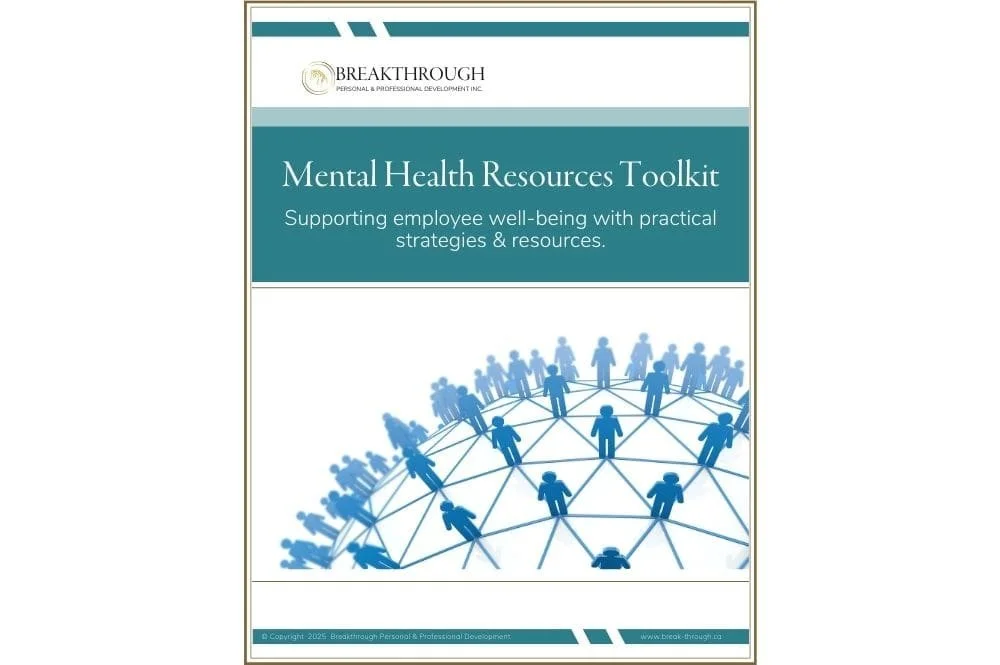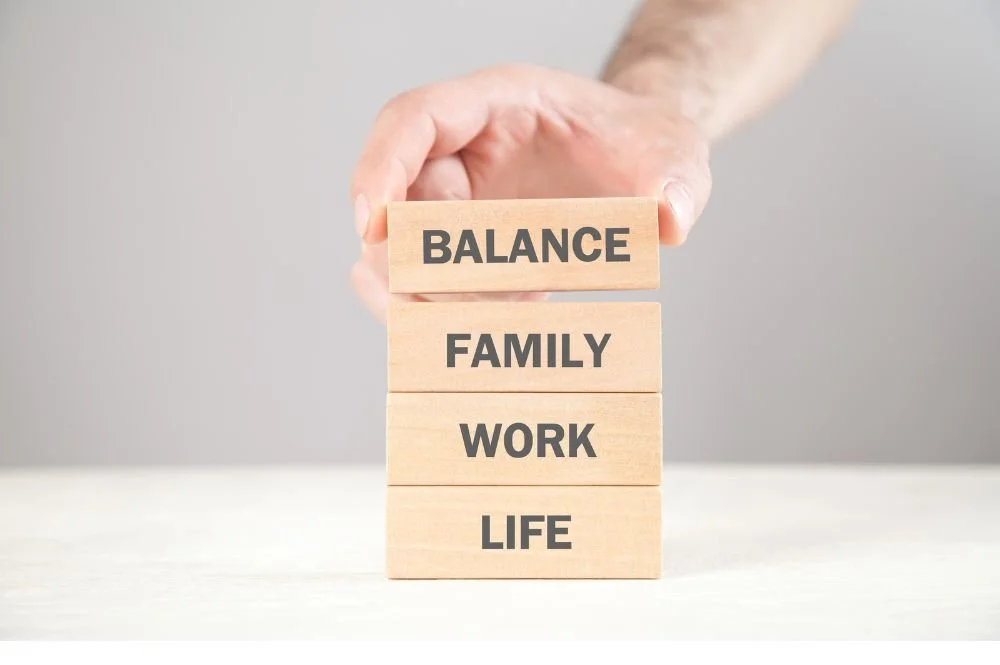Download a PDF copy of the Mental Health Resources Toolkit
Supporting employee well-being with practical strategies & resources.
Prioritizing employee well-being through mental health support is essential. A healthy, happy team is more productive, engaged, and resilient and less likely to suffer from workplace stress, burnout or compassion fatigue. This guide provides mental health resources for
Organizational leaders, managers, employees and frontline staff;
Military, RCMP, police and first responders;
Caregivers and those who may experience vicarious trauma on the job.
Scroll down for the Mental Health Resources Toolkit.
Practical strategies to cultivate a supportive & thriving workplace.
1. Encourage Open Conversations
Cultivate a workplace environment that encourages open conversations about mental health.
Lead by Example: Share appropriate personal stories to normalize conversations about mental health, occupational stress, burnout, vicarious trauma, moral injury and compassion fatigue.
Demonstrate Empathy: Listen attentively to understand employees' challenges and offer links to company-provided workflows, benefits, employee assistance programs and workplace wellness resources.
Ensure Privacy: Protect employees’ confidentiality to foster psychological safety, trust and openness.
2. Promote Work-Life Balance
Enable employees to maintain a healthy work-life balance via workplace and extracurricular resources.
Flexible Work Arrangements: Provide employee-driven options for remote work or flexible hours where feasible, while maintaining connection for collaboration and innovation.
Encourage Breaks: Ensure employees take regular breaks to rejuvenate during work hours. Consider providing stress management exercises, wellness rooms and outdoor spaces for staff to go for a walk or eat lunch in nature.
Discourage Overwork: Establish and model boundaries to prevent excessive working hours through disconnecting from work policies and best practices.
3. Provide Mental Health Resources
Ensure that employees have access to the resources they need to support their mental health and prevent burnout, compassion fatigue and occupational stress.
Employee Assistance Programs (EAPs): Offer confidential counselling, benefits packages and support.
Mental Health Training: Host training workshops to educate and equip workers with strategies for mental health and well-being. Some topics include stress management, burnout prevention, mitigating vicarious trauma and compassion fatigue, resilience, self-care and healthy boundaries.
Mental Health Resources: Refer to the following resource toolkit for a variety of useful links.
4. Recognize and Reward Efforts
Acknowledge and value the excellent and innovative work of both individual employees and teams.
Verbal Recognition: Consistently offer verbal praise during team meetings for exceptional work. Create environments that celebrate team efforts during group coffee breaks, lunchtime gatherings, or professional development days.
Written Acknowledgments: Send thank-you notes or emails to individuals that highlight specific achievements. Additionally, provide employees with consistent feedback on their performance and thank them for even a routine job well done.
Incentive Programs: Establish reward programs to honour exceptional performance. While monetary incentives are always appreciated, small recognitions, such as gift certificates for food and beverages or fitness memberships, go a long way to creating a positive work environment where staff feel valued.
5. Foster Social Connections
Create opportunities for employees to connect and build relationships both inside and outside of work.
Team-building activities: Organize regular team-building activities to foster employees’ connection and collaboration company-wide, within teams, or departments. Consider utilizing personality profiling resources, such as the Enneagram, for teams to foster cohesion, mitigate conflict, and enhance communication.
Social events: Host social events to provide employees with opportunities to connect outside of work. This is especially important for community-minded millennials and Gen Z employees.
Mentorship programs: Establish mentorship programs to connect employees with experienced colleagues, allowing them to learn the skills necessary to excel in their roles while fostering meaningful relationships.
6. Educate and Train Leaders
Provide leaders and managers with the essential knowledge and skills to enhance their team’s mental health and well-being.
Mental Health Awareness Training: Equip leaders with the ability to recognize signs of distress, burnout and compassion fatigue through practical sector-specific workshops and training.
Communication Skills Training: Develop leaders' proficiency in effective communication and active listening, enabling them to ask intelligent, empathetic questions that foster a psychologically safe environment.
Healthy Boundary Training: Implement onboarding training for new leaders and managers to equip them in their relationships with direct reports. Provide workshops that enable senior staff to maintain healthy boundaries, understand why they may inadvertently cross their boundaries when helping others, and know what to do when direct reports act in a manner that is detrimental to themselves, their coworkers, clients, or stakeholders.
Implementing these mental health strategies can foster an organizational culture that values, supports, and empowers employees. Prioritizing employee well-being boosts productivity, reduces absenteeism, and fosters engagement, ultimately benefiting both your employees' lives and your organization's success.
“Happy, healthy employees create healthy organizations that thrive.”
-Bonita Eby, CEO, Breakthrough Personal & Professional Development Inc.
Mental Health Resources Toolkit
Download a PDF copy of the Mental Health Resources Toolkit
Mental Health Resources for Burnout, Compassion Fatigue & Workplace Stress
Breakthrough Personal & Professional Development
Resources for burnout prevention and mental health services for both organizations and individuals via workshops, training, consulting, coaching and assessments.
Traumatic Stress Institute of Klingberg Family Centers
Trauma-informed measurement and implementation resources.
The Mental Health Continuum Model (MHCM)
A tool provided by the Government of Canada in collaboration with the United States Marine Corps to monitor and manage mental health.
Centre of Expertise on Mental Health in the Workplace
Mental health in the workplace resources for organizations, managers and employees.
Compassion Fatigue Assessment
Professional Quality of Life free compassion fatigue assessment.
Burnout Assessment
Free burnout assessment, including both professional and personal profiles.
Mental Health Resources for First Responders, Military and Veterans
Peer support for military and RCMP personnel
Operational Stress Injury Social Support (OSISS) and Support for Operational Stress Injury (SOSI) programs for the Canadian Armed Forces and Royal Canadian Mounted Police.
Veterans Affairs Canada
Services for current or former members of the Canadian Armed Forces (CAF) or RCMP, or a family member.
PSPNET
Mental health and wellbeing resources for first responders.
PTSD Coach Canada
A mobile app to learn about and manage symptoms of PTSD.
RCMP National Reintegration Program
Resources for officers returning to work after experiencing trauma.
Canadian Institute for Public Safety Research and Treatment
CIPSRT provides public safety wellness for public safety personnel.
Homewood Health Centre
Residential Mental health and additions centre. Programs for first responders, military and veterans.
Wounded Warriors
Mental health services for trauma-exposed professionals.
Gift From Within
PTSD Insights and Support for Survivors and Caregivers.
SHIFT Wellness
Resources and support for those who work in internet child exploitation crimes and their families.
General Mental Health Resources
Canadian Mental Health Association
330 community locations across Canada offering mental health supports, including many free options. Find your local CMHA
ConnexOntario
Free information on health services for mental health, addictions and problem gambling.
211 Ontario
Information and referrals to community and social services in Ontario in 150 languages.
BounceBack
Free self-help programs for those experiencing anxiety and depression.
Abiliti CBT
Free internet-based Cognitive Behavioural Therapy program for mental health.
9-8-8: Suicide Crisis Helpline
Bilingual support for those with concerns about suicide.
Strongest Families Institute
Tools and resources for families and youth.
Kids Help Phone
Mental health support for youth.
The Family Caregiver Toolbox
Resources for caregivers around specific challenges such as depression and bereavement, with articles, videos and directories.
eMentalHealth
Self-screening assessments for many mental health concerns.
Mental Health Resources in Kitchener, Waterloo, Cambridge & Guelph
Homewood Health Centre
Residential Mental health and additions centre. Programs for first responders, military and veterans.
Grand River Hospital Mental Health and Addictions
Mental health and addictions programs and support for children, youth and adults.
Waterloo Region Suicide Prevention Council
Education, training and support to reduce suicide and its impact.
Breakthrough Personal & Professional Development
Resources for burnout prevention and mental health services for both organizations and individuals via workshops, training, consulting, coaching and assessments.
Your trusted partner in employee health.
About the author
Bonita Eby is a Burnout Prevention & Organizational Culture Consultant, Executive Coach, and owner of Breakthrough Personal & Professional Development Inc., specializing in burnout prevention and wellness for organizations and individuals. Bonita is on a mission to end burnout.






